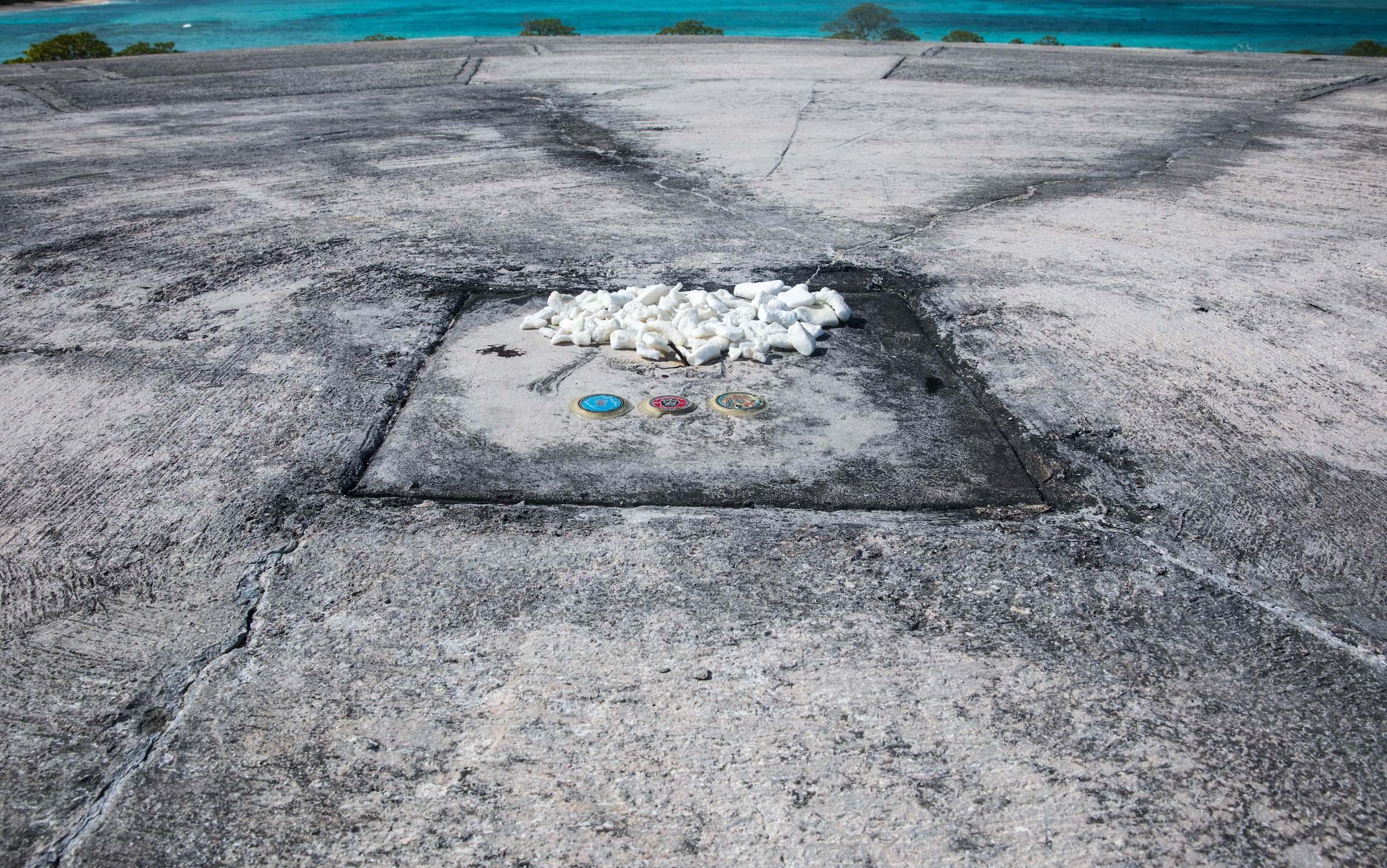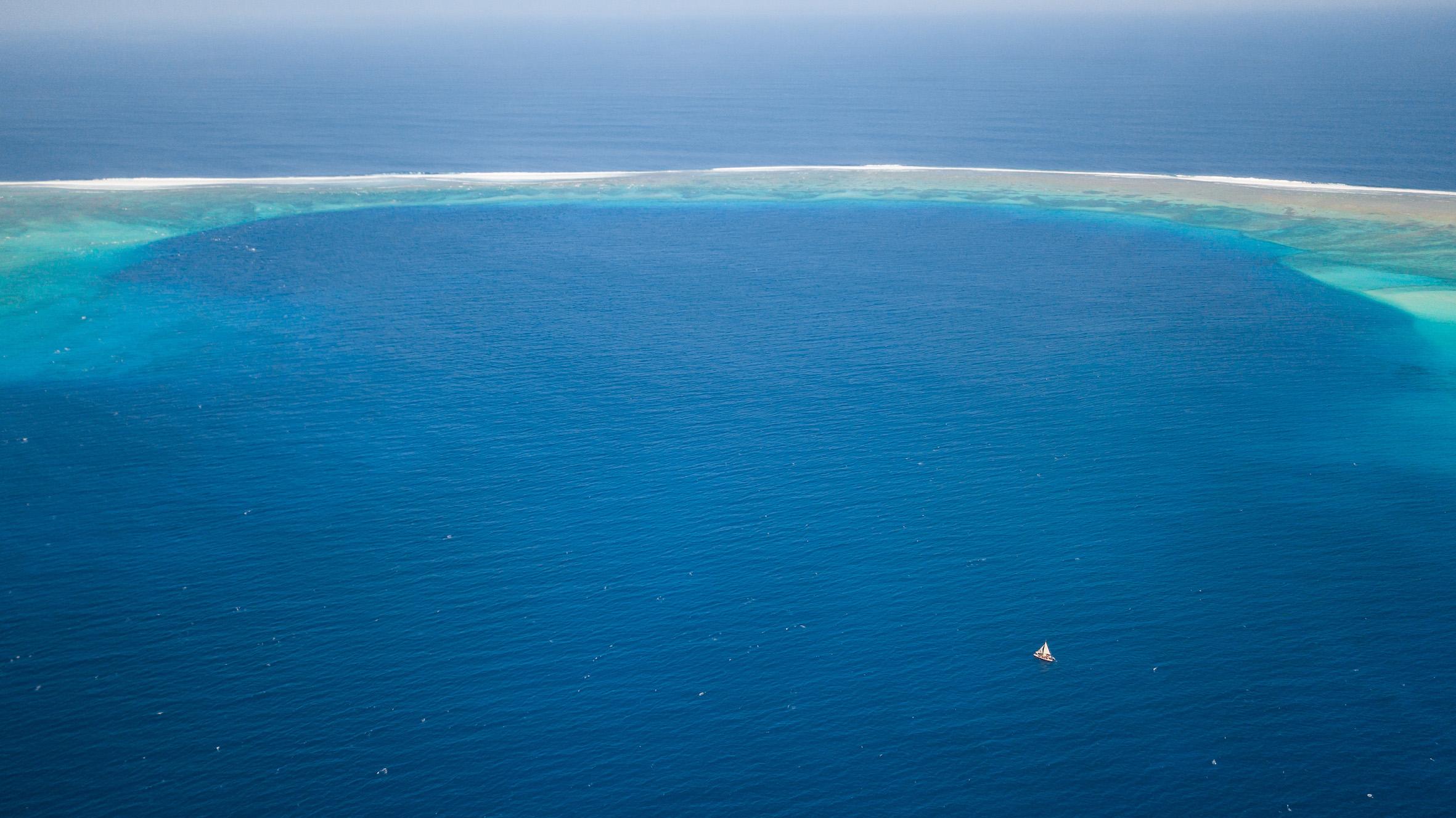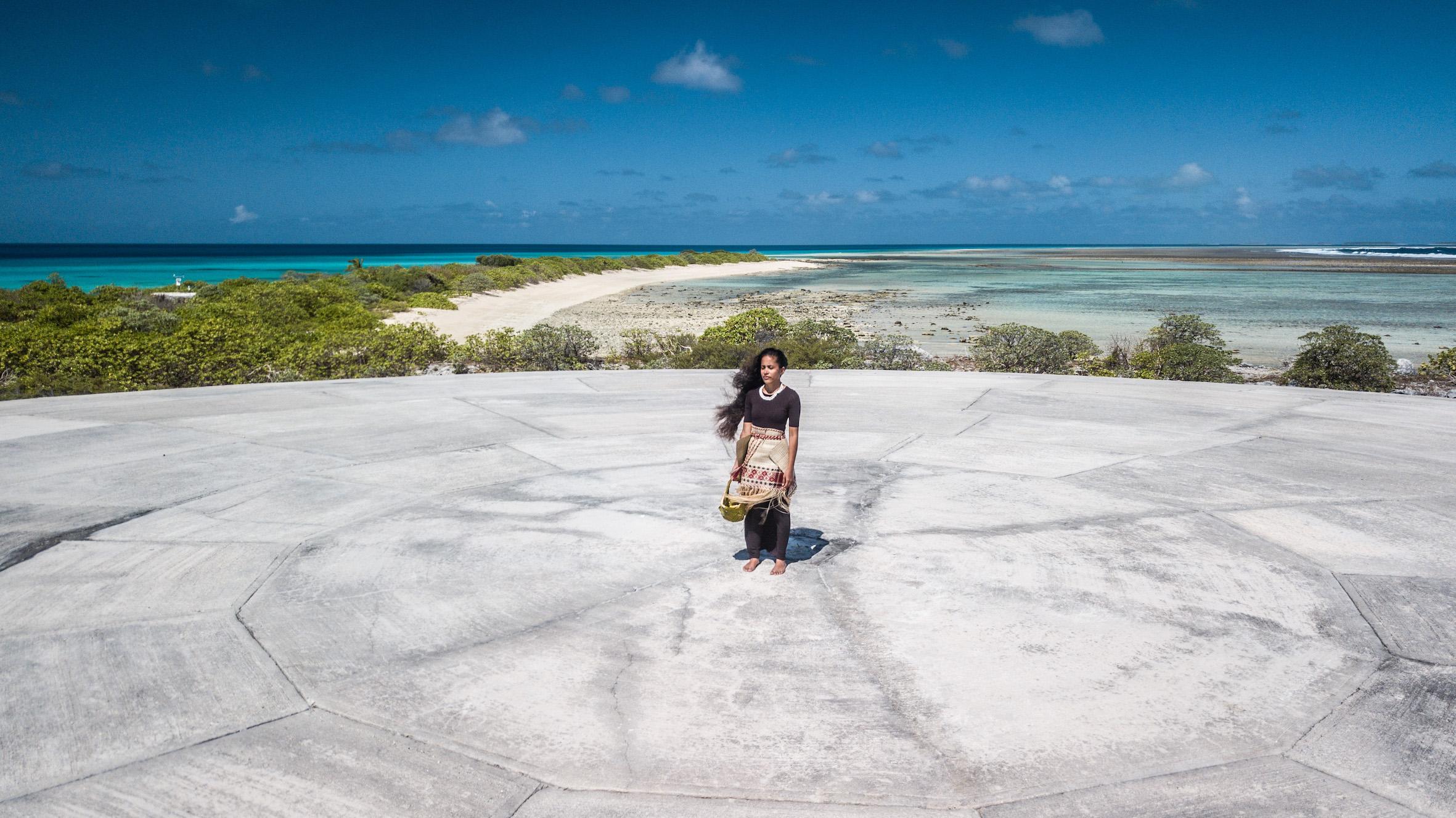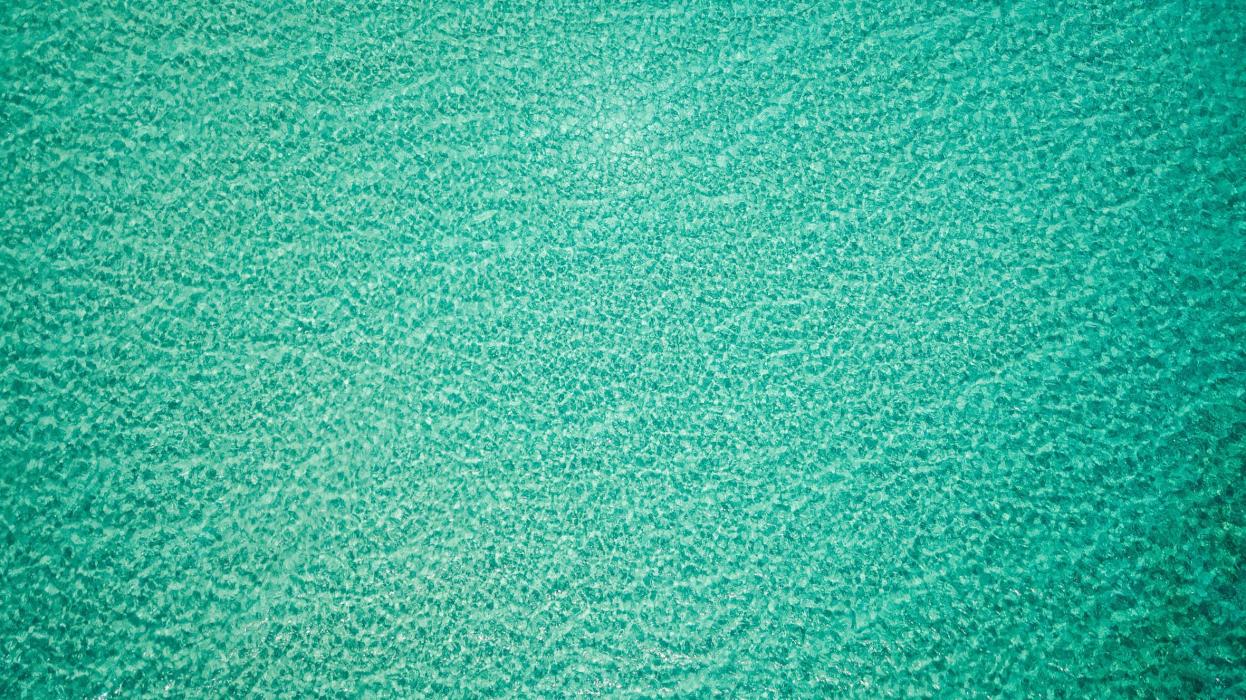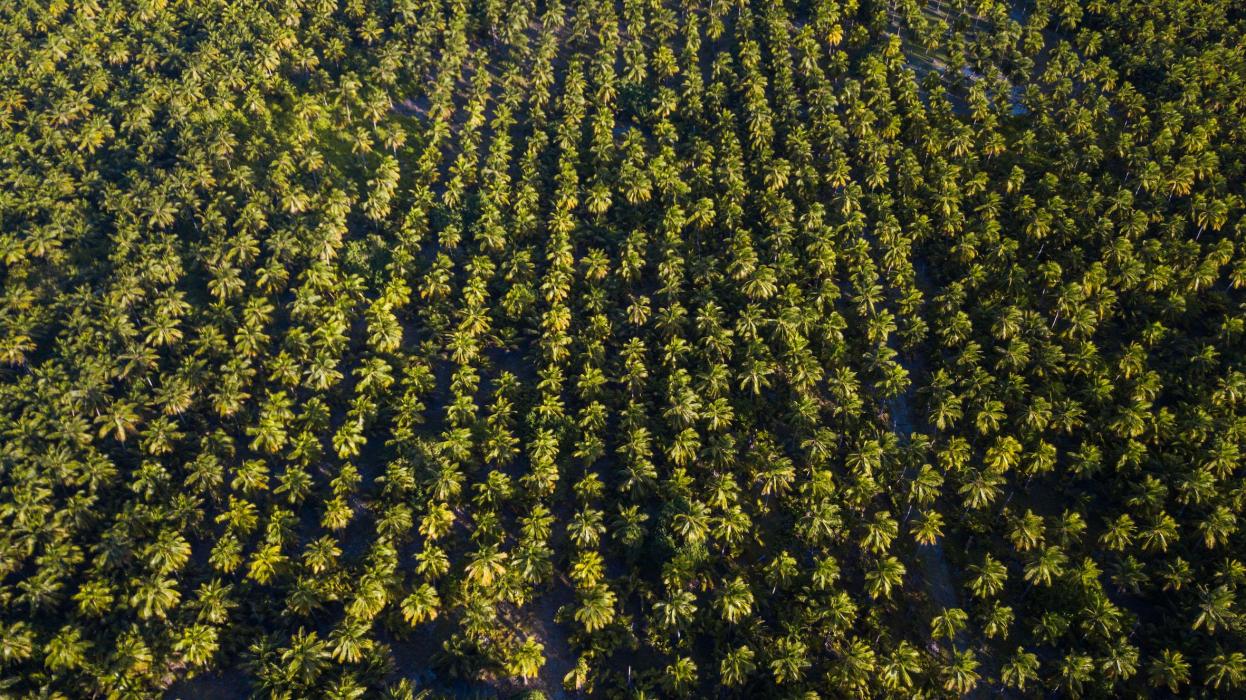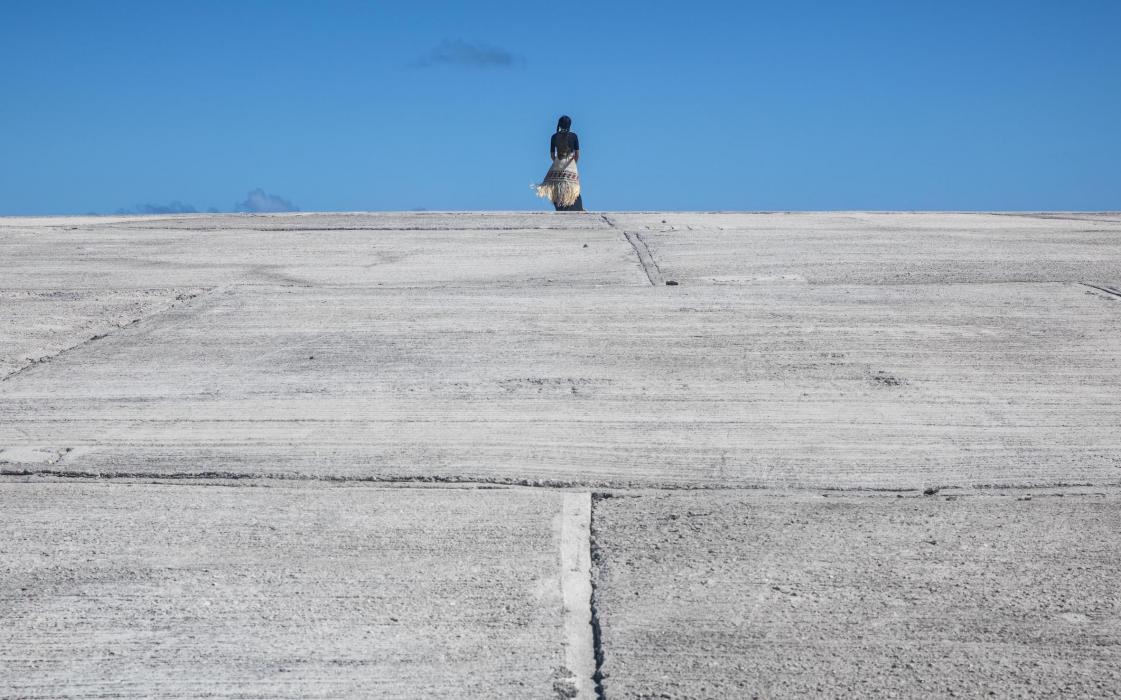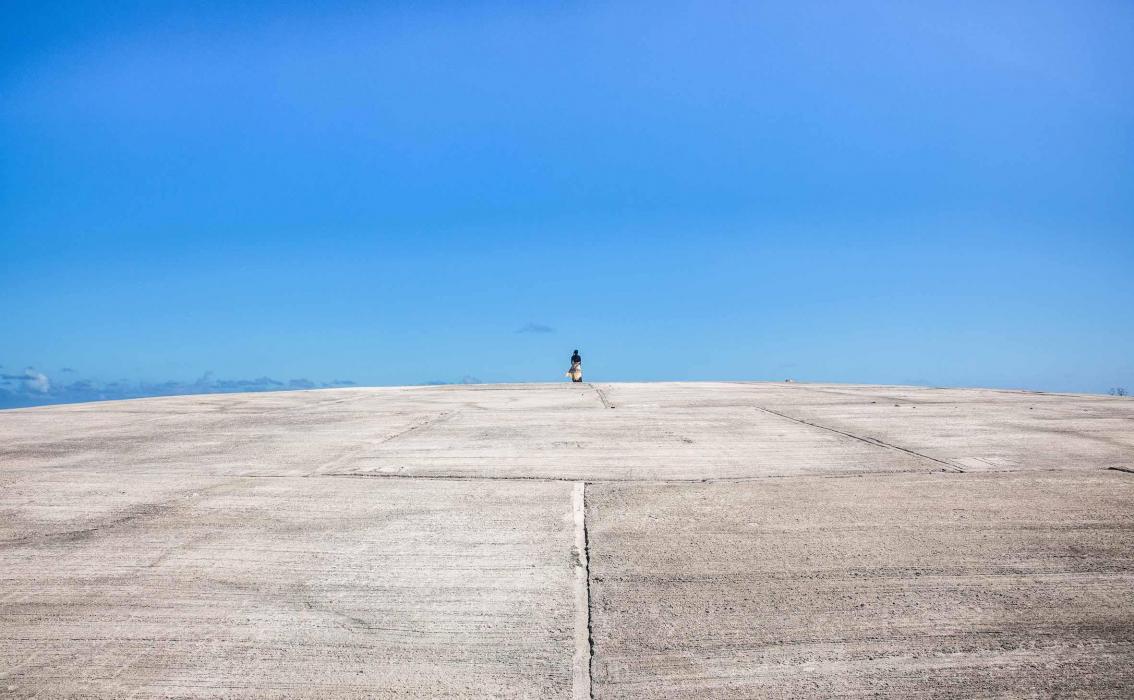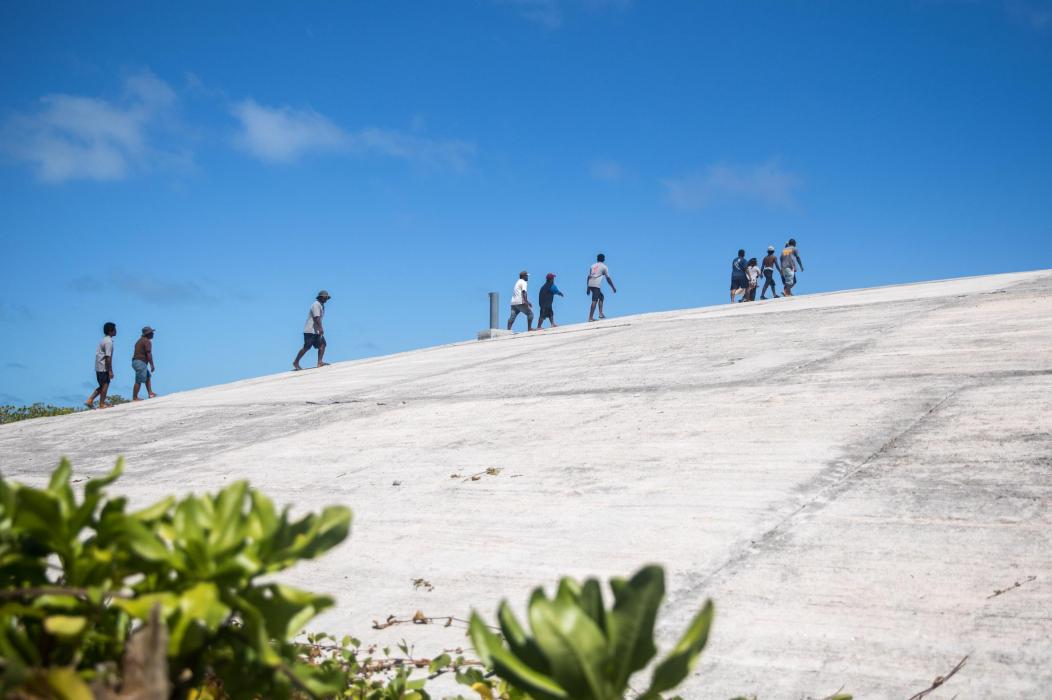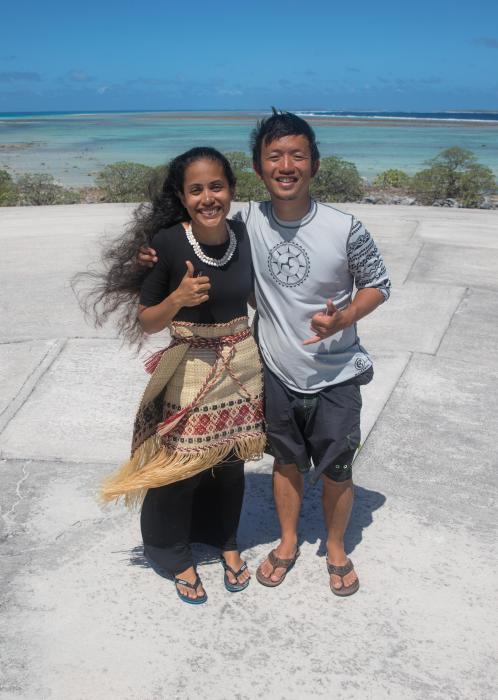‘A story of a people on fire’: nuclear archives and Marshallese cultural memory in Kathy Jetñil-Kijiner’s 'Anointed'
Anointed, produced by PREL, written by Kathy Jetñil-Kijiner and directed by Dan Lin, 2018.
Prior to western colonial incursions into Oceania, Indigenous Pacific communities were interlinked through multiple networks of trade and oceanic travel, sharing in common a vast ‘sea of islands’ that were later divided by Europeans into the geocultural categories of Polynesia, Melanesia and Micronesia. As the late Tongan writer Epeli Hau‘ofa notes, there is a ‘world of difference’ between figurations of Oceania in Indigenous cosmologies – in which islands are understood as part of a ‘universe’ comprising not just land surfaces but ‘the surrounding ocean … the underworld with its fire-controlling and earth-shaking denizens, and the heavens above with their hierarchies of powerful gods and named stars and constellations’ – and colonial representations of the Pacific as small, remote, sparsely populated ‘islands in a far sea’. [1] Western conceptions of the Pacific as ‘empty space’ or the ‘hole in the doughnut’ of the Pacific Rim underpinned Cold War geopolitics, as Britain, France and the United States selected nuclear testing sites remote from their own metropolitan centres, but located within their own colonial or semicolonial spheres of influence.
Between 1946 and 1958 the United States undertook 67 nuclear tests in the Marshall Islands, which at that time was incorporated within its UN-mandated Strategic Trust Territory of the Pacific Islands. The northern atolls of Bikini and Enewetak were chosen on the basis of their remoteness from international air and sea routes, with the spurious claim that their occupants were a ‘nomadic’ people ‘pleased’ to vacate their putatively resource-poor islands while the United States developed its nuclear technology ‘for the good of mankind and to end all world wars’. [2] By the time testing ended, Bikini Atoll was so catastrophically irradiated that it is considered uninhabitable for at least 24,000 years (the half-life of the plutonium-239 that contaminates its land and waters), while the people of Enewetak - who were displaced in 1947 to make way for the tests, and could not return until the US belatedly completed a partial decontamination of their islands in the late 1970s - came back in 1980 to find over half their atoll, and their entire lagoon, still heavily contaminated. Eight per cent of Enewetak’s land areas had been destroyed by the 43 nuclear tests undertaken in the northern area of the atoll between 1948 and 1958; the largest of these (known as the ‘Mike’ test, with a yield of 10.4 megatons, 750 times greater than the Hiroshima bomb) vaporised an entire island and left a crater a mile in diameter and 200 feet deep. [3] Those southern areas of the atoll that were considered by the US to be safe for habitation were so badly damaged (through land-clearing for testing-era construction of buildings, runways and roads; nuclear fallout; and the subsequent removal of topsoil during the partial cleanup) that to this day the people who live there are heavily reliant on imported food for survival.
The loss of, and damage to, customary land is of immeasurable cost to the people of Enewetak. The Marshall Islands are spread across two million square kilometres of ocean but the total land area is only around 180 square kilometres, comprising 29 coral atolls and five islands averaging less than two metres above sea level. On such terrain it takes centuries to establish a soil deep and rich enough in nutrients to sustain a community, and parcels of land (weto) were passed down through generations who cultivated the soil and also buried their dead within it, rendering the land sacred as well as life-giving. The Enewetak nuclear tests ruptured centuries of connection between ri-Enewetak (the people of Enewetak) and their homeland, firstly by displacing them to the neighbouring, resource-poor atoll of Ujelang to make way for the tests (an exile that the US military governor had told them would last no more than three to five years, but in fact lasted more than three decades), and then irrevocably damaging and contaminating their lands and waters.
The partial cleanup of Enewetak took place between 1977 and 1980, and involved some 4,000 US servicemen dumping over 100,000 cubic yards of irradiated soil, plutonium, scrap metal and other debris into a large crater - created by the 1958 ‘Cactus’ bomb test - on Runit Island. This was intended as a temporary solution to the problem of nuclear waste on Enewetak, and an original plan to line the bottom of the crater with concrete was abandoned, with the waste, mixed into a concrete slurry, dumped directly onto the permeable soil of the cavity and capped with an 18-inch-thick dome comprising 357 concrete panels. At around 114 metres (374 feet) in diameter, the dome (variously known as the Runit Dome, the Cactus Dome, or ‘The Tomb’ to ri-Enewetak) dominates the northern tip of Runit, and while the whole island remains heavily contaminated as a result of the 17 nuclear tests conducted on, above, or in the water around Runit, concerns are growing about the fact that rising sea levels and expanding cracks within the concrete are expediting the process of radioactive isotopes leaking from the dome into the lagoon, and drifting to the community living 15 miles downwind on the south-eastern island of Enewetak. The US considers the 1986 Compact of Free Association agreement to have ended its responsibility over areas affected by its nuclear testing programme in the Marshall Islands, though in 2012 Congress passed legislation requiring the Secretary of Energy to review the structural integrity of the dome, and measure groundwater radiation levels around it, at least every four years. A risk assessment of the dome was undertaken by the Department of Energy in early 2020, and its ensuing report claimed that the dome was still structurally sound and that radioactive leakage into the lagoon was not significant enough to warrant intervention. The report failed to allay the concerns of the Marshallese government – and ri-Enewetak – who have repeatedly requested that the contaminated waste be removed from the Marshall Islands. [4]
Given that radioactive contamination is invisible, the dome, while not quite constituting a ‘concrete archive’ (to reference this journal’s current theme), is nevertheless both a repository and starkly visible marker of the remnants and legacies of US nuclear violence in the Marshall Islands. More than just an assemblage of radioactive debris, the site contains a buried archive of sedimented layers of Marshallese material and cultural history in the once-fertile soil that lines its interior. This content is hidden from view by the concrete cap of the dome, which ostensibly serves as a memorial only to the US servicemen who constructed it, and as a record of US nuclear violence in Enewetak: at its very centre, the dome features three plaques, the first of which enumerates the nuclear tests and lists the sites where they took place, while the other two commemorate the US military task force and government departments implementing and overseeing the cleanup. (see figures 1 and 2)
The dome has become the focus of a kind of ‘dark tourism’: although Runit Island is still officially off-limits due to its high levels of radioactive contamination, there is no fence around it (or personnel to patrol it; see figure 3), and a number of western journalists, film-makers and other visitors have photographed, filmed and walked on the dome in recent years. This has generated a large archive of visual images of the dome (and portentous narratives to accompany them, often focused on the radiogenic cancers and other illnesses afflicting the former US servicemen involved in the nuclear cleanup), but as Marshallese poet and environmental activist Kathy Jetñil-Kijiner points out, little attention has been paid to the history and cultural significance of the island itself. [5] In the remainder of this essay, I consider the ways in which Anointed, a 2018 video poem by Jetñil-Kijiner (made in partnership with film-maker/photographer Daniel Lin), juxtaposes the visual and textual archive of US atomic discourse on the dome with another kind of archive – Marshallese cultural memory and legends, relating to Runit Island, that precede and contest the hegemonic discourse of nuclear apocalypse.
These archives and discursive layers are linked with specific temporalities and modalities within the original poem, as well as within the video itself. Kathy researched and wrote a full draft of the poem before visiting the island, and the text records her desire to transcend the depersonalised rhetoric of atomic discourse – a familiar narrative, accessible through the vast Cold War archive of US Department of Energy and Department of Defense documentation, and referenced in the video through archival footage of multiple nuclear bomb detonations filmed by the US military. As Kathy observes, the nuclear bombardment and subsequent interment of radioactive waste on the island ostensibly transformed it into a ‘concrete shell … solidified history, immovable, unforgettable’, but she reflects that there ‘must be more to this’ than the US atomic archive records. [6] The dome itself serves to efface the history and presence of Enewetak’s Indigenous peoples by cementing a teleology based around US military incursion, with the plaques at its centre clinically cataloguing the locations of the multiple bomb tests and memorialising the labours of the US servicemen who created this ‘tomb’. As Jacques Derrida points out, ‘the archive takes place at the originary and structural breakdown of the said memory’ an apt description for the post-apocalyptic narratives and imagery that have gathered around the dome since its construction—and incremental decay. [7]
Other sections of Kathy’s poem, however, explore an alternative archive: the rich repository of Marshallese oral history and legend attached to Runit island and its people. Kathy’s referential methodology bears comparison to Patrick Chamoiseau’s notion of ‘trace-memoires’ (memory-traces); as he argues, ‘Dessous l’Histoire colonial écrite, il faut trouver la trace des histoires’ (Beneath written colonial History, one must find the traces of histories). [8] While researching the poem, for example, Kathy spoke to a ri-Enewetak woman who revealed that Runit Island used to be known as the ‘pantry of the chiefs’, due to the wealth of the marine and land-based food sources available there. [9] The poem juxtaposes the sterile, desolate, desert-like imagery associated with the nuclear destruction on Runit with the former fecundity of the island, replete with ‘breadfruit trees heavy with green globes of fruit’, ‘beds of ripe watermelon … swollen with juice’, and coconut trees (which provide fluid as well as food—essential sustenance on coral atolls with so few sources of fresh water). The poem also makes reference to a local legend linking the fertility of ri-Enewetak women with significant events in the atoll’s pre-nuclear history: two chiefly women, from warring factions on either side of Enewetak’s lagoon, ‘swam pregnant for miles’ across the lagoon, and made a pact that if one of them gave birth to a boy and the other to a girl, the children would later marry and the rival factions would be at peace. In the local legend this duly comes to pass, and there is a particular poignancy about this narrative of reconciliation and intergenerational continuity being invoked in the context of nuclear violence on Runit, as the poem juxtaposes the fertility of these legendary women with the sterile ‘empty belly’ of the crater where the dome now stands.
The dome’s convex ‘shell’ is linked to another Marshallese legend referenced in the poem: the story of the turtle goddess Lijobake, who ‘gifted one of her sons, Letao, a piece of her shell, anointed with power’. [10] Letao is a notorious trickster in Marshallese legend, and he uses the power of the shell to ‘turn himself into kindling for the first fire’, which he introduces to humankind by giving a basket of hot coals to a small boy. The boy takes the basket to his house to show his parents, but the ensuing fire gets out of control and nearly ‘burn[s] his entire village to the ground’, much to the amusement of Letao. Kathy’s poem contrasts the elemental energy of Letao’s fire with the unnatural ‘blazing heat’ of the nuclear detonations that ‘consumed’ Runit ‘one by one’. She ends the poem by asking a question: ‘Who anointed them [the US] with the power to burn’?
This final sentence draws attention to the sacrilegious arrogation of power by the architects of the Manhattan project: President Truman famously said of the nuclear bomb, ‘We thank God that it has come to us, instead of to our enemies; and we pray that He may guide us to use it in His ways and for His purposes’. [11] As Elizabeth DeLoughrey has noted, in the early years of the US nuclear programme, politicians, journalists, and other commentators invoked tropes of ‘a new dawn, a rising sun, and the birth of a new world’, positing the bomb ‘as the product of a new kind of divinity’ assumed by man through technological innovation. [12] Anointed draws attention to the hubris behind this human usurpation of power over elemental forces, and resonates with another of Kathy’s poems, ‘History Project’, which juxtaposes the hegemonic narratives of the US atomic archive with the testimonies of islanders exposed to nuclear fallout. She devotes particular attention to the narratives of irradiated women who developed reproductive problems, including multiple miscarriages, stillbirths, and giving birth to children with severe birth defects. As Kathy notes in Anointed, ‘this is a story of a people on fire’: while nuclear fallout from the US tests fell most heavily on the northern atolls (including several inhabited areas located downwind from the testing sites), it also reached the islands and atolls further south, leaving a deadly legacy of cancers and leukaemia, blood and metabolic disorders, thyroid tumours and other diseases that afflict Marshall Islanders to this day. As I have argued elsewhere, this can be understood within the context of what Rob Nixon calls ‘slow violence’ – a ‘delayed destruction that is dispersed across time and space’. [13]
Anointed records both personal and collective grief for this ‘people on fire’, particularly in its invocation of rituals associated with the eorak, a Marshallese funerary custom conducted at a burial site three days after interment. During this ceremony, family members place white stones on the grave, symbolising the resolution of, and forgiveness for, any interpersonal tensions or past wrongs within the family. In the text of Kathy’s poem, she mourns the fact that on Runit ‘there will be no white stones to scatter around this grave’, but significantly, the video poem reveals her placing the customary stones – fragments of coral – next to the American plaques on top of the dome, thereby transforming it from a monument to US military hubris into a kind of countermonument, something that, as Erica Johnson notes, can shift emphasis from the object itself to its ‘affective impact … on the viewer’ (see figure 4). [14] As Kathy has observed, the video poem conveys ‘the idea that I am mourning this island – not the dome’. [15] In this context, it is significant that for the majority of the video poem, the dome is only partially visible and often out of focus, shifting the viewer’s attention away from this alien structure and towards the body of the poet moving through the landscape that surrounds it. Kathy uses personification when describing the island (‘I’m coming to meet you’) and has revealed the nervous anticipation she felt about encountering a landscape she considered to be ‘a person’. [16] Such lexis invokes the symbiotic relationship between body and land discussed earlier in this essay, thereby contesting hegemonic western figurations of the Pacific as ‘empty space’ by reasserting Indigenous presence (with)in the landscape.
This presence is asserted in multiple sequences tracking Kathy as she walks barefoot through the partially regenerated scrub surrounding the dome, and subsequently across the dome itself, while she weaves Indigenous narrative strands across this unnatural structure. (see figure 5) The multiple temporalities referenced in the poem – the island as it was before the nuclear era; the time of the nuclear tests; the construction of the dome; the time of Kathy writing the poem; and the visit to the dome itself – are visually underscored by alternating images of Kathy wearing different items of clothing, from t-shirts and modern machine-made dresses to the traditional jaki-ed, a finely woven clothing mat. (see figure 6) These changes of clothing emphasise Kathy’s presence as the poet-I experiencing an affective encounter with the places referenced in the poem, but also (particularly when she wears the jaki-ed) posit her as an embodiment of the people of this place, ri-Enewetak, as well as the generations of Marshall Islanders who have suffered the consequences of US nuclear testing. As she reflects, the nuclear legacy is ‘burning all of us’, and the video features footage not just of her, but also ri-Enewetak people, as well as people from other parts of the Marshall Islands, including members of her own family.
During February 2018, when the Anointed video poem was filmed, our project team was also able to visit Bikini Atoll (on a double-hulled canoe, incorporating Indigenous Pacific design features, belonging to the Marshallese branch of the Okeanos Foundation for the Sea), and in Anointed film-maker Daniel Lin alternates between footage of Runit (and the inhabited island of Enewetak) and images of Bikini Atoll. [17] These scenes include relics of the Cold War era - such as abandoned Atomic Energy Commission buildings, scorched blocks of concrete, and nuclear testing detritus along the shoreline - as well as images of the Bikini lagoon, grievously scarred by the 1954 BRAVO bomb—which, at 15 megatons, was the largest and ‘dirtiest’ thermonuclear bomb in the history of US nuclear testing. (see figure 7) Such footage metonymically contextualises the destruction on Runit within the entire history of nuclear devastation in the Marshall Islands (where, to this day, US ballistic missiles are still being tested on Kwajalein atoll, as a manifestation of the military power America still exercises in the Marshall Islands as a consequence of the agreements formalised in the 1986 Compact of Free Association).
As if to underscore this broader historical context, as Kathy utters the final words of the poem, the camera’s point of view shifts, zooming out from a close-up view of the poet in an aerial shot that allows the viewer finally to grasp the full dimensions of the dome beneath her feet. (see figure 8) This shift in perspective draws the viewer’s attention to the magnitude of the nuclear violence indexed in the poem, but importantly, although Kathy’s body now looks increasingly petite (in comparison to the dome’s monstrosity) as the drone used for this footage moves higher into the sky, she is still visible to the end, occupying the centre of the dome, reasserting the presence and endurance of the Marshallese people in spite of their erasure and marginalisation within atomic discourse. This island, Anointed reveals, is more than waste(d) land, more than a nuclear waste dump, more than the desert(ed) island of the western imaginary; it is an integral part of a vast Marshallese ‘sea of islands’, and its history is conveyed to us through the archive of stories the poet invokes, and in the contemporary affective narrative the video poem creates. [18]
Notes
[1]. Epeli Hau‘ofa, We Are The Ocean: Selected Works, University of Hawai‘i Press, Honolulu, 2008, p. 31.
[2]. See Sasha Davis, The Empire’s Edge, University of Georgia Press, Athens and London, 2015, pp. 60-65, for detail on the propagandist US film footage and military discourse surrounding the displacement of Marshall Islanders prior to the nuclear testing. See Jack Niedenthal, For the Good of Mankind: A History of the People of Bikini and Their Islands, Bravo, Majuro, 2011, for Marshallese perspectives on the displacement of Bikini islanders, the first community to be evacuated to make way for US nuclear testing (in 1946).
Ri-Enewetak views on their displacement are well summarised in Davor Pevec, ‘The Marshall Islands Nuclear Claims Tribunal: The Claims of the Enewetak People’, Denver Journal of International Law and Policy, vol. 35, no. 1, winter 2006, pp. 221-239.
[3]. Davor Pevec, ‘The Marshall Islands Nuclear Claims Tribunal: The Claims of the Enewetak People’, p. 223.
[4]. See https://www.energy.gov/sites/prod/files/2020/06/f76/DOE-Runit-Dome-Report-to-Congress.pdf and https://www.latimes.com/environment/story/2020-07-01/us-says-nuclear-waste-safe-marshall-islands-runit-dome.
[5]. Kathy Jetñil-Kijiner, Interview with Tamera Heine, Youtube, 2018, https://www.youtube.com/watch?v=uAT-Zxg8MPc.
[6]. In quoting the text of the poem I use the final version available on Kathy’s blog, https://www.kathyjetnilkijiner.com/dome-poem-iii-anointed-final-poem-and-video/).
[7]. Jacques Derrida, Archive Fever: A Freudian Impression, trans. Eric Prenowitz, University of Chicago Press, Chicago, 1996, p. 4.
[8]. Patrick Chamoiseau and Rodolphe Hammadi, Guyane: Traces-mémoires du bagne, Caisse nationale des monuments et sites historiques, Paris, 1994, p. 15; translation Erica L. Johnson in Cultural Memory, Memorials, and Reparative Writing, Palgrave, New York, 2018, p. 45.
[9]. Jetñil-Kijiner, Interview, n.p.
[10]. A version of this legend can be found in Dirk Spenneman’s online archive of Marshallese legends, Digital Micronesia, under the title ‘Letao gave fire to the people’, http://marshall.csu.edu.au/Marshalls/html/legends/frame-le-3-2.html.
[11]. See Paul Boyer, By the Bomb’s Early Light: American Thought and Culture at the Dawn of the Atomic Age, Pantheon Books, New York, 1985, p. 211; and Harry Truman, ‘Awful Responsibility’, Time, 20 August 1945, p. 29.
[12]. Elizabeth DeLoughrey, ‘Heliotropes: Solar Ecologies and Pacific Radiations’, in Elizabeth DeLoughrey and George Handley (eds), Postcolonial Ecologies: Literatures of the Environment, Oxford University Press, Oxford, 2011, pp. 235-53 (p. 246).
[13]. Rob Nixon, Slow Violence and the Environmentalism of the Poor, Harvard University Press, Cambridge, Mass., 2011, p. 2; Michelle Keown, ‘War and Redemption: Militarism, Religion and Anti-Colonialism in Pacific Literature’, in Michelle Keown, Andrew Taylor and Mandy Treagus (eds), Anglo-American Imperialism and the Pacific: Discourses of Encounter, Routledge, London and New York, 2018, pp. 25-48 (p. 34).
[14]. Patrick Chamoiseau and Rodolphe Hammadi, Guyane: Traces-mémoires du bagne, Caisse nationale des monuments et sites historiques, 1994, translation Erica L. Johnson in Cultural Memory, Memorials, and Reparative Writing, 2018, p. 71.
[15]. Jetñil-Kijiner, Interview, n.p.
[16]. Jetñil-Kijiner, Interview, n.p.
[17]. The Anointed video poem was made as part of a nuclear legacy project that also involved creative writing and other community engagement activities with children and adults in Enewetak. Anthologies of creative writing by children from Enewetak and the displaced Bikini community can be found at www.map.llc.ed.ac.uk. The project team’s journey from Majuro to Enewetak and Bikini on the Okeanos canoe is of particular significance given the centuries-old long-distance oceanic navigation traditions–which enabled interconnections between the Pacific’s vast ‘sea of islands’ - referenced both in Kathy’s poem and in Epeli Hau‘ofa’s scholarship.
[18]. The research informing this essay was supported by funding from the UK’s Economic and Social Research Council (ESRC) and the Arts and Humanities Research Council (AHRC), via the Global Challenges Research Fund (GCRF).





